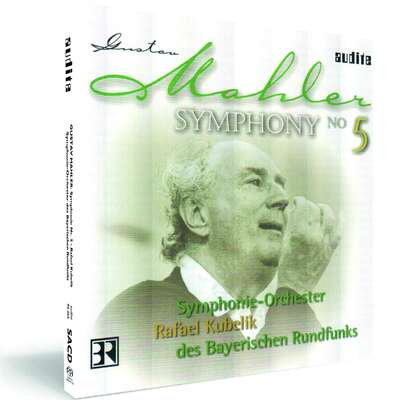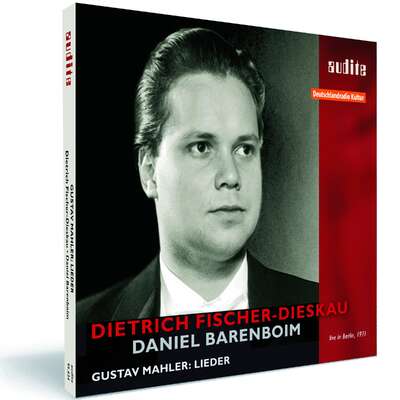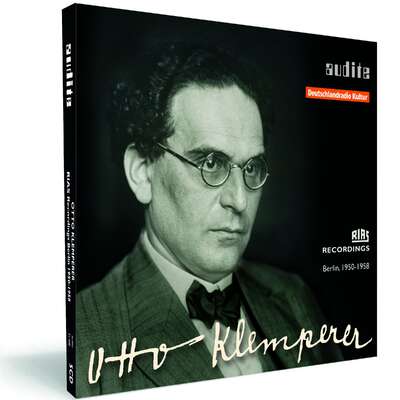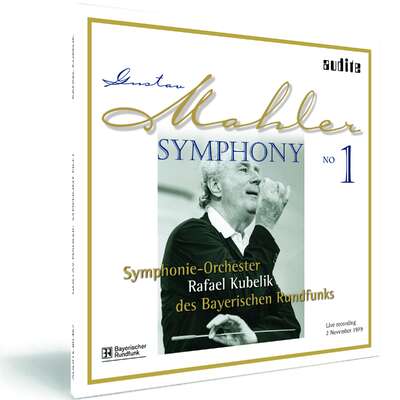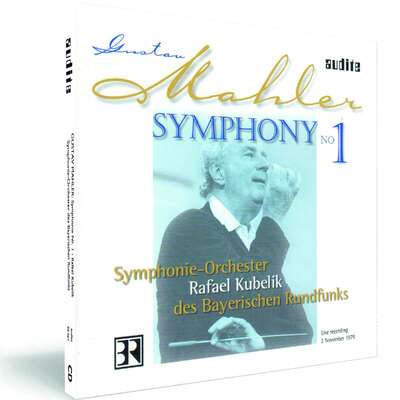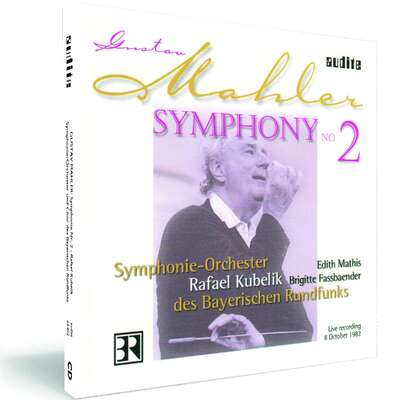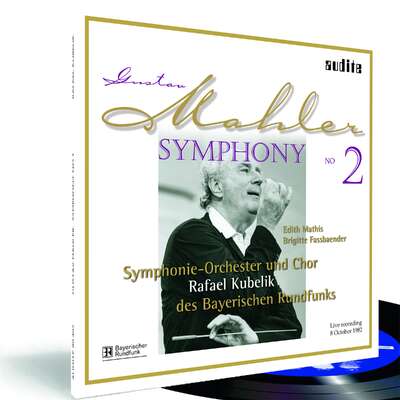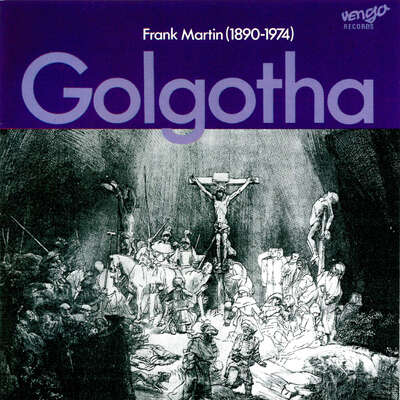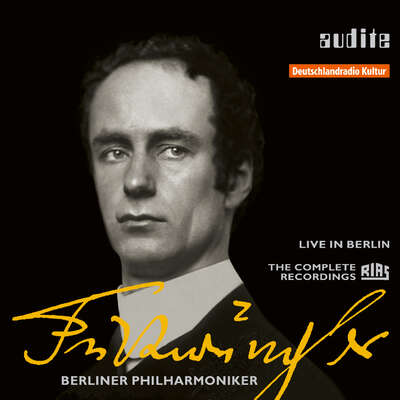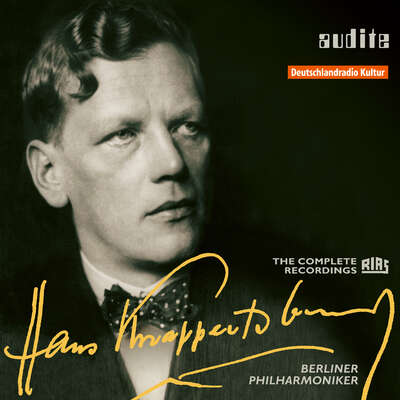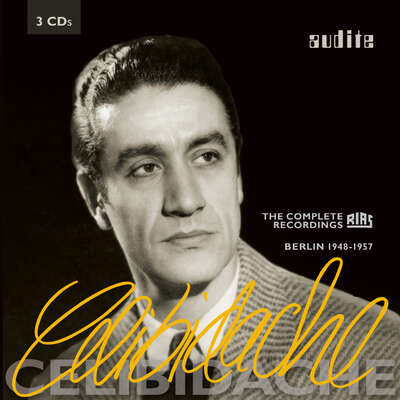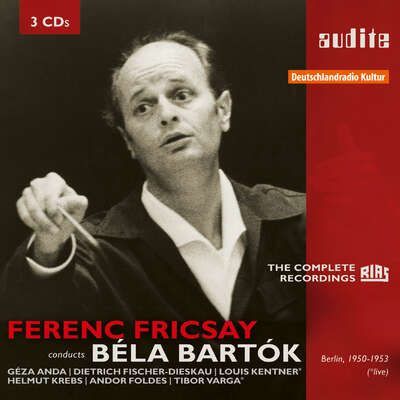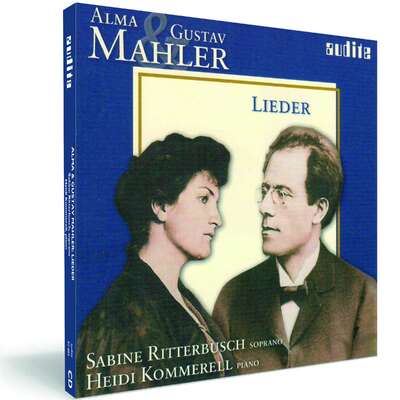
Ever since the young Rafael Kubelik became acquainted with the music of Gustav Mahler - primarily through conductors such as Bruno Walter, Erich Kleiber and Fritz Busch - his fascination with it never again left him alone. He pressed forward with the Mahler Renaissance in post-war Germany as one of...more
"All in all, a breath of fresh Moravioan air and a wonderfully civilised alternative to the hi-tech histrionics of today's market leaders." (Gramophone)
Details
| Gustav Mahler: Symphony No. 5 | |
| article number: | 95.465 |
|---|---|
| EAN barcode: | 4009410954657 |
| price group: | BCB |
| release date: | 1. January 1999 |
| total time: | 71 min. |
Informationen
Ever since the young Rafael Kubelik became acquainted with the music of Gustav Mahler - primarily through conductors such as Bruno Walter, Erich Kleiber and Fritz Busch - his fascination with it never again left him alone. He pressed forward with the Mahler Renaissance in post-war Germany as one of its main protagonists against the initially reserved attitude of the public and critics. In Munich, he realised one of the first complete Mahler cycles. The fruitful collaboration over many decades between Kubelik and the Bavarian Radio Symphony Orchestra reached unique high points in Mahler's symphonies again and again. Mahler's Fifth Symphony appears here in a live recording from the Herkulessaal of the Munich Residenz made on 12 June 1981.
This live recording is also available on 2 LPs: aud 80465: G. Mahler: Symphonie Nr. 5 (Rafael Kubelik, Symphonie-Orchester des Bayerischen Rundfunks)
Reviews
WETA fm | Saturday, 11.21.09, 4:00 am | Jens F. Laurson | November 21, 2009
WETA will have finished playing through the three complete Mahler cyclesMehr lesen
CD Compact | n°174 (marzo 2004) | Francisco Javier Aguirre | March 1, 2004 Audite/Rafael Kubelik
El intenso patriota que fue este director checo, celebró el regreso a suMehr lesen
www.musicweb-international.com | 01.08.2003 | Gerald Fenech | August 1, 2003
Kubelik's Mahler credentials have long been established ever since his trailblazing Decca recording of the First with the VPO in 1957 indeed manyMehr lesen
Scherzo | N° 175, Mayo 2003 | Enrique Pérez Adrián | May 1, 2003
El sello alemán Audite comienza ahora a ser distribuido en España y loMehr lesen
El País
| 19.04.2003 | Javier Pérez Senz | April 19, 2003
Kubelik, en el corazón de Mahler
Dos sinfonías de Gustav Mahler grabadas en vivo abren la edición que el sello Audite dedica al director checo Rafael Kubelik, uno de los grandes mahlerianos de la historia.
[...] dirige el célebre adagietto con un encendido lirismo y una intensidad que hipnotiza al oyente –, situándose entre las mejores de la discografía.Mehr lesen
Classic Record Collector | 10/2002 | Christopher Breunig | October 1, 2002
The German firm Audite has given us not only this near complete live cycle of Mahler symphonies (sans 4 or 8), but valuable Kubelik/Curzon readings ofMehr lesen
Recorded between 1967 and 1971, Kubelik’s DG cycle has been at budget price for some time now and the Audite alternatives of 1, 5 and 7 have been in the shops for months. The NHK-recorded Ninth, made during a 1975 Tokyo visit by the Bavarian RSO, was reviewed in CRC, Spring 2001 (I found the sound unfocused and the brass pinched in sound, but welcomed in particular playing ‘ablaze’ after the visionary episode in the Rondo burleske and a crowning final). No. 1 in DG is widely admired but this 1979 version is more poetic still, wonderfully so in the introduction and trio at (II). There is something of a pall of resonance in place of applause, cut from all these Audite transfers. In No. 7 the balance is more airy than DG’s multi-miked productions, and (as in No. 5) Kubelik sounds less constrained than when working under studio conditions, although rhythm in the opening bars of (II) goes awry and the very opening note is succeeded by a sneeze! The disturbing and more shadowy extremes are more vividly characterized, the finale a riotous display.
Some critics feel that Kubelik gives us ‘Mahler-lite’, which may seem in comparison with, say, Chailly’s Decca cycle or the recent BPO/Abbado Third on DG – not to mention Bernstein’s. But there is plenty of energy here, and the divided strings with basses set to the rear left give openness to textures. However, the strings are not opulent and the trumpets are often piercing. It would be fair to say that Kubelik conducted Mahler as if it were Mozart!
As it happens, in the most controversial of his readings, No. 6, the DG is preferable to the Audite, where Kubelik projects little empathy with its slow movement and where the Scherzo is less cohesive. The real problem is that the very fast speed for (I) affects ail subsequent tempo relationships. Nor does the finale on No. 3, one of the glories of the DG cycle, quite have the same radiance; the singers are the same, the Tölz Boys making a sound one imagines Mahler must have heard in his head, and this performance predates the DG by one month. Nevertheless, these newer issues of Nos 2 and 3 are worth hearing, the ‘Resurrection’ not least for Brigitte Fassbaender’s account of ‘Urlicht’.
Nowadays every orchestra visiting London seems to programme Mahler’s Fifth Symphony as a showpiece, but in 1951 (when Bruno Walter’s 78rpm set was the collector’s only choice) a performance would surely have been uncommon even at the Concertgebouw – Mengelberg was prohibited from conducting in Holland from 1946 until he died that year. Although the start of (V) is marred by horns, this is an interesting, well executed account with a weightier sound, from what one can surmise through the inevitable dimness – the last note of (I) is almost inaudible. The three versions vary sufficiently to quote true timings (none is given by Tahra): (I) 11m 34s/12m 39s/11m 35s (Tahra/Audite/DG); (II) 13m/14m 52s/13m 52s; (III) 15m 56s/17m 54s/17m 23s; (IV) 9m 24s/10m 24s/9mm 44s); (V) 14m 26s/14m 57s/15m 29s. The live Munich version is tidier than on DG; the spectral imagery in (III) is heavier in effect, too; and in the Adagietto the dynamic and phrasing shadings and poetic quality of the string playing also give the live performance the edge. Towards the end of the finale, and elsewhere, the engineers reduced dynamic levels.
Tahra’s booklet comprises an untidily set-out synopsis of Kubelik’s career. Audite’s have full descriptions of the works with text for Nos 2 and 3, and different back-cover colour portraits of the conductor.
International Record Review | 10/2002 | Christopher Breuning | October 1, 2002
The German firm Audite has given us not only this near complete live cycle of Mahler symphonies (sans 4 or 8), but valuable Kubelik/Curzon readings ofMehr lesen
Recorded between 1967 and 1971, Kubelik’s DG cycle has been at budget price for some time now and the Audite alternatives of 1, 5 and 7 have been in the shops for months. The NHK-recorded Ninth, made during a 1975 Tokyo visit by the Bavarian RSO, was reviewed in CRC, Spring 2001 (I found the sound unfocused and the brass pinched in sound, but welcomed in particular playing ‘ablaze’ after the visionary episode in the Rondo burleske and a crowning final). No. 1 in DG is widely admired but this 1979 version is more poetic still, wonderfully so in the introduction and trio at (II). There is something of a pall of resonance in place of applause, cut from all these Audite transfers. In No. 7 the balance is more airy than DG’s multi-miked productions, and (as in No. 5) Kubelik sounds less constrained than when working under studio conditions, although rhythm in the opening bars of (II) goes awry and the very opening note is succeeded by a sneeze! The disturbing and more shadowy extremes are more vividly characterized, the finale a riotous display.
Some critics feel that Kubelik gives us ‘Mahler-lite’, which may seem in comparison with, say, Chailly’s Decca cycle or the recent BPO/Abbado Third on DG – not to mention Bernstein’s. But there is plenty of energy here, and the divided strings with basses set to the rear left give openness to textures. However, the strings are not opulent and the trumpets are often piercing. It would be fair to say that Kubelik conducted Mahler as if it were Mozart!
As it happens, in the most controversial of his readings, No. 6, the DG is preferable to the Audite, where Kubelik projects little empathy with its slow movement and where the Scherzo is less cohesive. The real problem is that the very fast speed for (I) affects ail subsequent tempo relationships. Nor does the finale on No. 3, one of the glories of the DG cycle, quite have the same radiance; the singers are the same, the Tölz Boys making a sound one imagines Mahler must have heard in his head, and this performance predates the DG by one month. Nevertheless, these newer issues of Nos 2 and 3 are worth hearing, the ‘Resurrection’ not least for Brigitte Fassbaender’s account of ‘Urlicht’.
Nowadays every orchestra visiting London seems to programme Mahler’s Fifth Symphony as a showpiece, but in 1951 (when Bruno Walter’s 78rpm set was the collector’s only choice) a performance would surely have been uncommon even at the Concertgebouw – Mengelberg was prohibited from conducting in Holland from 1946 until he died that year. Although the start of (V) is marred by horns, this is an interesting, well executed account with a weightier sound, from what one can surmise through the inevitable dimness – the last note of (I) is almost inaudible. The three versions vary sufficiently to quote true timings (none is given by Tahra): (I) 11m 34s/12m 39s/11m 35s (Tahra/Audite/DG); (II) 13m/14m 52s/13m 52s; (III) 15m 56s/17m 54s/17m 23s; (IV) 9m 24s/10m 24s/9mm 44s); (V) 14m 26s/14m 57s/15m 29s. The live Munich version is tidier than on DG; the spectral imagery in (III) is heavier in effect, too; and in the Adagietto the dynamic and phrasing shadings and poetic quality of the string playing also give the live performance the edge. Towards the end of the finale, and elsewhere, the engineers reduced dynamic levels.
Tahra’s booklet comprises an untidily set-out synopsis of Kubelik’s career. Audite’s have full descriptions of the works with text for Nos 2 and 3, and different back-cover colour portraits of the conductor.
Rondo | 6/2001 | Oliver Buslau | June 1, 2001
Lorbeer + Zitronen
Was Rondo-Kritikern 2001 besonders gefallen und missfallen hat
Meine stille Liebe:<br /> die Wiederveröffentlichungen der Mahler-Sinfonien mitMehr lesen
die Wiederveröffentlichungen der Mahler-Sinfonien mit
Fono Forum | 4/01 | Gregor Willmes | April 1, 2001 Mahler ohne Manierismen
Im August jährt sich der Todestag von Rafael Kubelik zum fünften Mal. Die kleine, aber feine Schallplattenfirma audite pflegt sein AndenkenMehr lesen
Der Durchbruch Gustav Mahlers fand nicht im Konzertsaal statt. Zwar gab es nach seinem Tod einige Dirigenten, die wie Willem Mengelberg, Otto Klemperer und Bruno Walter Mahler noch kennen gelernt hatten und sich nachdrücklich auch im Konzertsaal für seine Sinfonien einsetzten. Doch verdankt Mahler mit Sicherheit seine Popularität zum großen Teil der Stereo-Schallplatte. Seine Sinfonien schienen wie geschaffen dazu, die Möglichkeiten der Studio-Technik darzustellen. So klingen die riesigen Sinfonien auf Tonträger oftmals sogar transparenter, als sie es im Konzertsaal je vermögen.
Leonard Bernstein war der erste, der Mitte der 60er Jahre mit dem New York Philharmonic für CBS (heute Sony) eine Gesamtaufnahme der Mahlerschen Sinfonien schuf, allerdings ohne das Adagio der unvollendeten Zehnten. Ihm folgte Rafael Kubelik, der mit dem Symphonieorchester des Bayerischen Rundfunks zwischen 1967 und 1971 im Herkules-Saal der Münchener Residenz alle Neune und den Adagio-Satz der Zehnten aufzeichnen ließ. Nur kurze Zeit später erschienen noch Gesamtaufnahmen von Bernard Haitink (Philips) und Georg Solti (Decca).
Ingo Harden zog im Dezember 1971 im Fono Form folgendes Fazit bezüglich der Kubelik-Aufnahmen: "Alles in allem: Der zweite vollständige Mahler-Zyklus hat in der Reihe der Mahler-Interpretationen der Gegenwart sein durchaus eigenes Profil, da sich von Bernsteins Aufnahmen durch ein Weniger an Leidenschaft und Pathos, ein Mehr an orchestraler Detailarbeit, einen helleren Grundton und eine emotional mehr den Mittelkurs haltende Darstellung unterscheidet." Harden stellte das Bild von Kubeliks "böhmischen Musikantentum" infrage, ohne es ganz abzustreiten, lobte darüber hinaus besonders die "sehr subtil und genau alle Klangfarben der Partituren aufschlüsselnden Aufführungen". In beidem ist Harden wohl Recht zu geben, wobei man nach meinem Dafürhalten allerdings Kubeliks tschechischen Wurzeln auch nicht unterschätzen soll, obwohl er sich (worauf Francis Drésel in seinem Aufsatz "Rafael Kubelik - Musiker und Poet" überzeugend hingewiesen hat) wie Mahler nach und nach "germanisiert" hat.
Rafael Kubelik wurde am 29. Juni 1914 in Bychorie bei Prag als Sohn des berühmten Geigen-Virtuosen Jan Kubelik geboren. Er studierte am Konservatorium in Prag Geige, Klavier, Dirigieren und Komposition. Er zählte also zu jener Kategorie von Mahler-Dirigenten, die wie Furtwängler und Klemperer oder wie später Bernstein und Boulez auch als Komponisten hervorgetreten sind. Das lässt vielleicht einerseits besser verstehen, warum Kubelik die musikalischen Zusammen hänge in Mahlers komplexen Sinfonien so einleuchtend darstellen konnte. Andererseits sagt das Komponisten-Dasein allein wieder auch nicht so viel über den Interpretationsstil aus, wenn man etwa an die Unterschiede zwischen Bernsteins expressivem und Boulez' analytischem Zugriff auf Mahler denkt.
Rafael Kubelik lernte Mahlers Sinfonien bereits in seiner Jugend in Prag kennen, zumeist dirigiert von Vaclav Talich,
aber auch von Gastdirigenten wie Bruno Walter, Otto Klemperer und Erich Kleiber. Für Kleibers Aufführung von Mahlers siebter Sinfonie leitete der 24-jährige Kubelik 1938 sogar die ersten Proben mit der Tschechischen Philharmonie.
Schnell machte Kubelik Karriere: 1939 wurde er Musikdirektor der Oper in Brünn, 1942 Leiter der Tschechischen Philharmonie. Später übernahm er Chefpositionen beim Chicago Symphony Orchestra und an den Opernhäusern Covent Garden London und Metropolitan New York. Seine zweite Heimat - nach Prag - wurde allerdings München, wo er von 1961 bis 1971 als Chefdirigent und noch bis 1985 als regelmäßiger Gast das Orchester des Bayerischen Rundfunks zu außergewöhnlichen Erfolgen führte.
Laut Erich Mauermann, dem damaligen Orchesterdirektor, war Kubelik der erste Dirigent der in München einen kompletten Mahler-Zyklus durchführte. Da er Mahlers Werke immer wieder auf den Spielplan setzte, sind einige Konzertmitschnitte erhalten, die jetzt nach und nach bei audite auf CD erscheinen. Friedrich Mauermann, Bruder von Erich Mauermann und mittlerweile in den Ruhestand getretener Ex-Chef von audite Schallplatten, hat die Reihe initiiert und dabei auf das Archiv des Bayerischen Rundfunks zurückgegriffen. Bei den Sinfonien eins, zwei und fünf hatte er sogar jeweils die Auswahl zwischen zwei verschiedenen Mitschnitten. "Wenn mehrere Aufnahmen derselben Sinfonie vorhanden waren", so Mauermann, "habe ich immer die jüngere genommen. Einerseits wegen des besseren Klangbildes, andererseits wegen der musikalischen Qualität. Die Gesamtzeiten der jüngeren Aufnahmen sind generell länger als die der älteren. Die Musik atmet mehr."
Die bisher veröffentlichten Mitschnitte der Sinfonien eins, zwei, fünf, sieben und neun stammen aus den Jahren 1975 und 1982 und wurden bis auf die neunte alle im Münchner Herkules Saal aufgenommen. Folgen sollen noch Mitschnitte der Sinfonien drei (1967) und sechs (1968), ebenfalls aus dem Herkules-Saal.
Somit stammen die bis jetzt vorliegenden Aufnahmen aus einer Zeit, die nach den Grammophon-Aufnahmen liegt. Und sucht man nach grundsätzlichen interpretatorischen Unterschieden, so stößt man zuerst auf die von Mauermann erwähnten langsameren Tempi der späteren Fassungen. Die "beiläufige" Schnelligkeit, die man den DG-Einspielungen bisweilen vorgeworfen hat, sind abgelegt. Vor allem in den Adagio- und Andante-Sätzen wählt Kubelik in späteren Jahren langsamere Tempi, beispielsweise im dritten Satz der ersten Sinfonie, aufgenommen am 2. November 1979. "Feierlich und gemessen, ohne zu schleppen" lautet die Satzbezeichnung, die Kubelik genau beachtet. Wunderbar baut er die Spannung auf, spielt das Crescendo aus, das allein durch das ständige Hinzutreten neuer Instrumente erreicht wird. Das Oboensolo ist überaus deutlich phrasiert, bildet im betonten Staccato einen Kontrapunkt zum Legato der Streicher. Das Parodistische des Satzes ist wesentlich besser getroffen als in der DG-Einspielung. Auch das "Ziemlich langsam" (Ziffer 5) wirkt in sich schlüssiger, man meint auf einmal einen Spielmannszug oder eine Klezmer-Kapelle zu hören.
Herrlich sind auch die ersten beiden Sätze des audite-Mitschnitts gelungen: "Wie ein Naturlaut" - kaum ein Dirigent
dürfte Mahlers Vorstellungen beim Beginn des ersten Satzes wohl so gut getroffen haben wie Kubelik in diesem Konzert. Dass die Stelle hier wesentlich überzeugender wirkt als in der DG-Einspielung, liegt auch in der Aufnahmetechnik begründet. Bei der Grammophon klingen die Stimmen isolierter, in der späteren Rundfunk-Aufnahme verschmelzen sie stärker: Das mindert etwas den analytischen Ansatz, verstärkt jedoch die Unmittelbarkeit der Naturstimmung. Hinzu kommt, dass das Orchester, besonders die Bläser, in der späteren Aufnahme noch souveräner wirken als in der ersten. Dass es sich um einen Konzertmitschnitt handelt, geht nirgendwo auf Kosten der künstlerischen Qualität. Das spricht für eine intensive Probenarbeit.
Die wesentlich bessere Aufnahmetechnik ist übrigens ein Charakteristikum, das fast alle audite-Produktionen auszeichnet. Die Konzertmitschnitte besitzen mehr räumliche Tiefe. Während die DG-Aufnahmen sehr auf Transparenz bedacht sind und immer wieder einzelne Instrumente oder Gruppen nach vorn ziehen, meint man bei den Rundfunkmitschnitten, wirklich ein Orchester im Saal der Residenz zu erleben. Und die Live-Aufnahme der neunten Sinfonie aus Tokios Bunka Kaikan Concert Hall klingt im Vergleich deutlich flacher als die Münchner Aufnahmen.
Was Kubeliks Mahler-Aufnahmen auch noch denen bei audite - gelegentlich fehlt, das ist die mitreißende Kraft, mit der sich etwa Bernstein in die schnellen Sätze warf. Das Finale der ersten Sinfonie ("Stürmisch bewegt") beispielsweise oder der zweite Satz der ansonsten interpretatorisch überzeugenden fünften ("Stürmisch bewegt, mit größer Vehemenz") weisen in dieser Hinsicht Defizite auf.
Den stärksten Eindruck der audite-Mitschnitte hinterlassen nicht zufällig jene Sinfonien, die solche Satzcharaktere
weitesgehend aussparen: die zweite und die siebte Sinfonie. So war der 8. Oktober 1982 ein wirklicher Glückstag für die Geschichte der Mahler-Interpretation. Denn Kubelik dirigierte die zweite an diesem Tag wie aus einem Guss: Alles fließt, nichts wirkt forciert im Allegro maestoso. Ein ungemein feinsinniges, schwereloses Musizieren zeichnet das Andante aus. Herrlich setzt Kubelik das Scherzo um. Das böhmisch-mährische Musikantentum - dem Ingo Harden einst so zweifelnd gegenüberstand - ist hier prächtig zu finden. Die Fischpredigt hält Kubelik leider nicht ganz so ironisch wie Bernstein. Dafür hat er mit Brigitte Fassbaender einen Alt, der das "Röschen rot" mit hinreißendem Timbre und klarer, sinnhaltiger Artikulation versieht. Im hervorragend gesteigerten Finale bilden Edith Mathis und Brigitte Fassbaender ein Traumpaar.
Genauso überragend ist die gerade auf CD erschienene siebte Sinfonie gestaltet. Sehr organisch meisterte Kubelik am 5. Februar 1976 die ständigen Tempowechsel im ersten Satz. Zauberhaft, dunkel getönt kommen die Nachtmusiken auf CD daher. Das Scherzo nimmt von Anfang an gefangen und lässt den Hörer nicht mehr los. Selbst das apotheotische Finale, mit dem viele Dirigenten Probleme haben, klingt bei Kubelik sinnvoll. Das Pathos wirkt nicht übertrieben, aber die Zuversicht bleibt.
Fazit: Mit diesen Mahler-Veröffentlichungen ist audite ein großer Wurf gelungen. Und wer bei Kubelik auf den Geschmack gekommen ist, der kann bei demselben Label auch noch hervorragende Mitschnitte von Beethoven- und vor allem Mozart-Konzerten bekommen, die Clifford Curzon mit dem Symphonieorchester des Bayerischen Rundfunks unter Kubelik in der Residenz gegeben hat. Aber Clifford Curzon ist schon wieder ein Thema für sich.
www.buch.de | 16.02.2001 | Olaf Behrens | February 16, 2001
Es muß schon ein wirklich großes Konzertereignis in München gewesenMehr lesen
fermate | 1/2001 | Christoph Dohr | January 1, 2001
Ohne Rafael Kubelik und das Sinfonieorchester des Bayerischen RundfunksMehr lesen
Der Tagesspiegel | 27.08.2000 | August 27, 2000 Der Schleier der Zeit
Historische Aufnahmen – wo setzt man sie an? Auch die 70er und 80er JahreMehr lesen
Classica | Juillet-Août 2000 | Maxim Lawrence | July 1, 2000
Ce label réédite dans d'excellentes conditions une gravure en public deMehr lesen
Répertoire | Juillet/Août 2000 | Pascal Brissaud | July 1, 2000
Ce concert nous fait redécouvrir à quel point Kubelik avait assimilé enMehr lesen
Berlingske Tidende | 21.06.2000 | Steen Chr. Steensen | June 21, 2000
I Kubeliks forunderlige verden
To enestàende optageIser af dirigenten Rafael Kubelik med Mahlers 1. og 5. Symfoni. Klassiske plader
Arene med det bayerske radiosymfoniorkester horer til de gyldne for denMehr lesen
Gramophone | June 2000 | Rob Cowan | June 1, 2000
... A more recent vintage of comparison was provided by two Audite releases of Mahler symphonies featuring the Bavarian Radio Symphony OrchestraMehr lesen
Symphony are hardly less striking. Both Performances are deeply poetic (I second DG\'s positive response to the Adagietto), less dramatic, perhaps, in orchestral attack than their studio predecessors, but kindlier, softerhued and - in the closing minutes of the Fifth\'s stormy second movement - markedly more grand. ...
Crescendo | Mai/Juni 2000 | TR | May 1, 2000
Mit zwei Live-Mitschnitten aus der Spätphase des großen Mahler-DirigentenMehr lesen
Gramophone Japan | April 2000 | David Gutman | April 1, 2000
Japanische Rezension siehe PDF!Mehr lesen
Gramophone | April 2000 | David Gutman | April 1, 2000 A pair of Mahler symphonies from the great Rafael Kubelik to complement his admired studio Mahler cycle
Rafael Kubelik\'s Mahler cycle (DG, 5/90) was a highlight of his period as chief conductor of the Bavarian Radio Symphony Orchestra (1961-79). It hasMehr lesen
Kubelik made one of the earliest studio recordings of the First Symphony, with the Vienna Philharmonic for Decca in the 1950s (1/55 - nla), and, on the first appearance of his DG remake in 1968, Deryck Cooke observed that here was an essentially poetic conductor who gets more poetry out of this symphony than any of the other conductors who have recorded it. That is even truer of this 1979 account, Cooke\'s \'natural delicacy \' being the key to an interpretation that may offend latterday purists. Kubelik\'s divided violins may be back in vogue, but not his abandonment of the first movement exposition repeat; he also ignores the single repeat sign in the Landler. Does it matter that the mood seems somehow \'old-fashioned\' as well - more autumnal than spring-like? One can hardly fail to be struck by the rural calm and simplicity he brings to the dreamy opening, the freshness and piquancy of the bucolic details, the birdcalls, the unfussy phrasing.
In the second movement, Kubelik keeps the music moving, as Bernstein almost fails to, yet still manages to impart a decent swing, while his Trio is a delight. Nor does he fall short in the slow movement, giving himself more time than Bernstein to impose a different but equally compelling ethnic slant. Most modern interpretations, however crisply focused, sound painfully flat after this. Only in the finale does the conductor\'s natural expressiveness veer towards a rhythmic slackness that saps the music of the necessary drive. The second subject, however gorgeous, is consolatory rather than rapt or yearning, the total effect something less than sensational.
By contrast, the Fifth is one of those performances that acquires charisma as it goes along. The first two movements are by no means earth-shattering, relying on the resonant recording (not quite as refined as No 1) to add gravitas to some less than committed music-making. The Scherzo is altogether more distinctive, frisky and lithe, with excellent work from the Bavarian horns. As for the Adagietto, this must now take its place among the most affecting on disc. Partisans of extreme tempos, whether fast or slow, may not like it, but Kubelik finds exactly the right pace - which is, of course, the pace that feels right for him; and his strings are possessed of an unearthly radiance. The finale of this symphony almost invariably sounds too heavy. Not so here. The conductor\'s rhythmic verve will surprise anyone familiar with the arthritic flailing of his later years and the conclusion is suitably vigorous.
All in all, a breath of fresh Moravian air and a wonderfully civilised alternative to the hi-tech histrionics of today\'s market leaders. The First Symphony sounds even better and is probably the one to go for.
BBC Music Magazine | April 2000 | David Nice | April 1, 2000 Kubelik’s live 1981
Mahler Fifth is a reminder that you can have everything in Mahler – intricate texturing, characterful playing, purposeful phrasing and a cumulativeMehr lesen
Applaus | 4/2000 | Martina Kausch | April 1, 2000
Großes Staunen
Live-Mitschnitte von Mahler- und Mozart-Konzerten unter Rafael Kubelik beweisen einmal mehr den Rang des BR-Symphonie-Orchesters
Im Jubeljahr des 50-jährigen Bestehens ist die Edition von Aufnahmen desMehr lesen
Stereoplay | März 2000 | Ulrich Schreiber | March 1, 2000
Im historischen Rückblick wächst die Hochachtung vor dem symphonischenMehr lesen
International Record Review | March 2000 | David Patmore | March 1, 2000
The specialist German label Audite has already released several recordings from Rafael Kubelik’s years as Chief Conductor of the Bavarian RadioMehr lesen
Kubelik took charge of the Bavarian Radio orchestra in 1961, and so this particular performance is a product of the close relationship between conductor and orchestra which had developed over a period of 20 years. The result is a notable reading: Kubelik gets completely inside the music, creating a performance of exceptional drive and intensity. The second movement, for instance, has a truly demonic character. The subsequent Scherzo is equally powerful, and the famous Adagietto is strongly contrasted, with an atmosphere of great repose. Only in the final movement does Kubelik’s intensity start to diminish. Taken as a whole, however, this performance represents a definite development on Kubelik’s earlier studio recording. It places his interpretation strongly within the expressionistic style of Mahler conducting, as epitomized most powerfully by Leonard Bernstein and Klaus Tennstedt.
The Bavarian orchestra plays with great eloquence, commitment and virtuosity, not least in the second movement, which constitutes the emotional core of Kubelik’s stormy view of the work. The only drawback, which does give cause for concern in this particular work but which presumably reflects the conductor’s intentions, is an at times raucous first trumpet.
As was so often the case, the Bavarian Radio recording of a performance in the Herkulessaal is a model of refinement. It presents an excellent overall aural picture, with wide perspective, in which all the strands of Mahler’s complex symphonic argument can be clearly heard without any artificial highlighting.
In sum, this recording, supported by brief but pertinent documentation is a valuable document of Kubelik’s later years, of his relationship with the orchestra with which he worked for the longest period of his whole career, and of a truly memorable interpretation of music clearly close to his heart.
Bergstädter Anzeiger | 02.02.2000 | hol | February 2, 2000
Dem tschechischen Dirigenten Rafael Kubelik ist eine der bedeutendstenMehr lesen
Pizzicato | Febr. 2000 | Rémy Franck | February 1, 2000 Kubelik mit Mahlers Fünfter
Gut, dass hin und wieder an die Rolle Rafael Kubeliks in der Verbreitung der Werke Gustav Mahlers erinnert wird. Diese Aufnahme ist umso erfreulicher,Mehr lesen
Eine hinreißend schöne Interpretation, die man wärmstens empfehlen muss.
Die Presse | 21.01.2000 | Wilhelm Sinkovicz | January 21, 2000
Rafael Kubelik war ein fulminanter Mahler-Interpret. Sein Nachruhm steht imMehr lesen
www.ClassicsToday.com | 01.01.2000 | David Hurwitz | January 1, 2000
Rafael Kubelik was one of this century\'s great conductors, and hisMehr lesen
fermate | Januar 2000 | Christoph Dohr | January 1, 2000
Das Spezialitäten-Label audite mit Sitz in Ostfildern wertet seit einigerMehr lesen
Musikmarkt | 06.12.1999 | December 6, 1999
Kubelik trug als Chef des Sinfonieorchesters des Bayerischen RundfunksMehr lesen
HMV Classic Information | December \'99 - Vol. 29 | Mitsuaki Sakamoto | December 1, 1999 Bekanntmachung des HMV Grand Prix!
Für die „HMV Classical Awards“ werden von zuständigen Personen derMehr lesen

